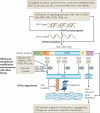Cycling hypoxia and free radicals regulate angiogenesis and radiotherapy response
- PMID: 18500244
- PMCID: PMC3943205
- DOI: 10.1038/nrc2397
Cycling hypoxia and free radicals regulate angiogenesis and radiotherapy response
Erratum in
- Nat Rev Cancer. 2008 Aug;8(8):654
Abstract
Hypoxia and free radicals, such as reactive oxygen and nitrogen species, can alter the function and/or activity of the transcription factor hypoxia-inducible factor 1 (HIF1). Interplay between free radicals, hypoxia and HIF1 activity is complex and can influence the earliest stages of tumour development. The hypoxic environment of tumours is heterogeneous, both spatially and temporally, and can change in response to cytotoxic therapy. Free radicals created by hypoxia, hypoxia-reoxygenation cycling and immune cell infiltration after cytotoxic therapy strongly influence HIF1 activity. HIF1 can then promote endothelial and tumour cell survival. As discussed here, a constant theme emerges: inhibition of HIF1 activity will have therapeutic benefit.
Figures





References
-
- Virchow R. Die Krankhaften Geschwulste. Hirschwald; Berlin: Aug, 1863. [The first report that vascular structures in tumours are abnormal.]
-
- Warren BA. In: Tumor Blood Circulation: Angiogenesis, vascular morphology and blood flow of experimental and human tumors. Peterson HI, editor. CRC Press; Boca Raton: 1979. pp. 1–48.
-
- Folkman J. Tumor angiogenesis: therapeutic implications. N. Engl. J. Med. 1971;285:1182–1186. [The first to suggest that inhibition of tumour angiogenesis could have therapeutic benefit.] - PubMed
-
- Vaupel P, Thews O, Kelleher DK, Hoeckel M. Oxygenation of human tumors: the Mainz experience. Strahlenther. Onkol. 1998;174(Suppl. 4):6–12. - PubMed
Publication types
MeSH terms
Substances
Grants and funding
LinkOut - more resources
Full Text Sources
Other Literature Sources
Medical
Research Materials

